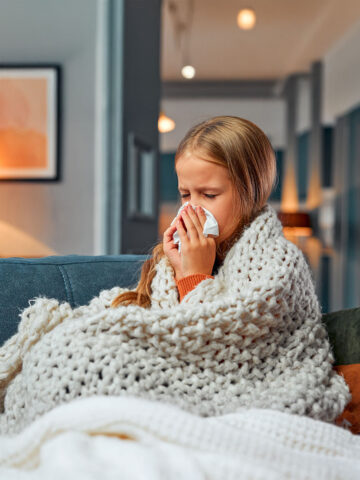How to protect your kids from harmful air and tips for reducing the risks of wildfires
In California, wildfires are becoming increasingly large and more severe. In part, climate change is to blame. However, no matter what causes them, wildfires can be scary, and parents may have questions about how to protect their kids.
Here, Dr. Marnie Granados, a CHOC pediatrician and member of CHOC’s sustainability task force, discusses how you can protect your child from breathing harmful air and what we can all do, as a community, to decrease the risk of wildfires.
How can parents protect their kids from breathing bad air caused by wildfires or air pollution?
When it comes to poor air quality, children are more vulnerable because they tend to spend more time outdoors playing or doing sports, says Dr. Granados. Additionally, their lungs aren’t as strong as adults, and they rely on parents or caregivers to keep them safe.
A child who is playing outside may not understand that they are having trouble breathing or that the air quality is bad.
There are some simple things that parents and caregivers can do to protect their kids during times of bad air quality, says Dr. Granados, like:
- If there is a wildfire in your area, check the air quality in your neighborhood on airnow.gov.
- If the air quality is poor, stay indoors as much as possible. If there is a wildfire nearby, close all windows and doors. When possible, set your air conditioner to recirculate.
- If your family has central heating or air, purchase an air filter that is rated MERV 13 or higher. This can help catch air pollutants at home.
- Avoid activities that may worsen indoor air quality like smoking, using commercial cleaning products or spraying artificial fragrances.
- If you have family members with chronic medical conditions, consider purchasing a high-efficiency particulate air filter (HEPA) filter to improve indoor air quality.
Are there any considerations for kids prone to respiratory issues during wildfires?
The lungs of infants, especially premature infants, aren’t as strong as older children or adults. This makes them more vulnerable to poor air quality.
Kids with asthma, or another chronic respiratory condition, should be extra careful during wildfires or periods of bad air quality.
Are wildfires getting worse in the U.S.?
In California, we know that wildfires are becoming larger and more severe, says Dr. Granados. The three main contributing factors to this include:
- Climate change: Warmer weather conditions and the lack of rain increase the risk of large, extreme wildfires. The weather can contribute to an abundance of dry vegetation, which will burn faster and more easily.
- An increase in homes built on the Wildland Urban Interface (WUI): The WUI refers to the zone where human development and unoccupied land meet. For example, this refers to home communities on the base of hills or close to grass or vegetation. Home building on the WUI can eliminate precious, undeveloped land while increasing the risk of accidental fires (for example, due to electrical systems which lead to wildfires and the destruction of homes).
- Forest management: About 100 years ago, the United States created a policy to suppress fires. Because of this, there is not enough controlled burning allowed to maintain all the flammable dry fuel (grass, shrubs and bushes) that we have in the U.S.
Are wildfires causing worsening air pollution or air quality in the U.S.?
When there is a wildfire event in California, or anywhere, it’s going to impact the air quality of surrounding communities. Wildfire smoke contains many harmful compounds, says Dr. Granados.
One compound that can specifically impact human health is particulate matter (PM). The U.S. Environmental Protection Agency (EPA) describes particulate matter (also called particle pollution) as the mixture of solid particulates and liquid droplets found in the air.
The burning of wood – like during a wildfire – can worsen air pollution and cause particulate matter to enter the air, causing air pollution.
PM10 particles refer to inhalable particulates that can be seen with the human eye – like small pieces of dust, dirt or soot floating in the air. However, smaller particulates which can’t be seen without a microscope – called PM2.5 particles – can be breathed in deeper into the lungs, causing damage to them.
PM 2.5 particles can be especially dangerous for kids because the small particulates can cause inflammation and damage to the lungs. Children who have been diagnosed with a chronic lung disease, such as asthma, could experience a worsening of their symptoms when exposed to higher levels of PM2.5.
Wildfire smoke can also contain volatile organic compounds like formaldehyde that can irritate your eyes, nose and airways.
In the United States, what can we do to help our air quality?
To help decrease the risk of wildfires and to improve air quality, in general, Dr. Granados suggests that families:
- Try to drive their cars less. Carpool or try to consolidate errands or work into a few days, rather than spreading them out throughout the week.
- Try to fly less. Consider more local trips in your state or region to reduce the amount of commercial airline tickets that you buy.
- Think about how you consume goods. The further away a product is made from you, the longer it must travel to get to you. Because of this, that product will burn more fossil fuels during its travel time. Consider purchasing more local items, such as made-in-America goods or produce from farmer’s markets.
- Consider shipping less. With more businesses offering inexpensive, fast shipping, it can be tempting to order everything you need from the comfort of your home. Consider consolidating your orders so they are shipped together or picking up the items you need from somewhere local. Measure your carbon footprint. As a family, consider learning more about how many resources you use with an environmental footprint calculator. Then, discuss some simple changes you can make as a family to reduce your environmental impact.
- Decide not to purchase a home located at the Wildland Urban Interface, if possible. Consider the risk associated with buying a home at the WUI and weigh your options as a family.
Is there anything else you want parents to know about air pollution and wildfires?
For families who do live on the WUI, make sure to come up with an evacuation safety plan, says Dr. Granados. In the event of needing to evacuate due a wildfire, have a list of important items that you can grab quickly before leaving. Don’t forget any medications you may need for family members.
Although the threat of wildfires can be scary, it’s important to remember that there are things we can do – both as families and communities — to help decrease the risk, says Dr. Granados. By considering simple changes to improve air quality and reduce our carbon footprint, we can help ensure that our future generations will be able to enjoy a beautiful Earth and have clean air to breathe.
For more health and wellness resources from the pediatric experts at CHOC, sign up for the Kids Health newsletter.
Find a CHOC Primary Care Pediatrician
From babies to teens, pediatricians from CHOC’s Primary Care Network partner with parents to offer immunizations, sick visits, sports physicals and more.





